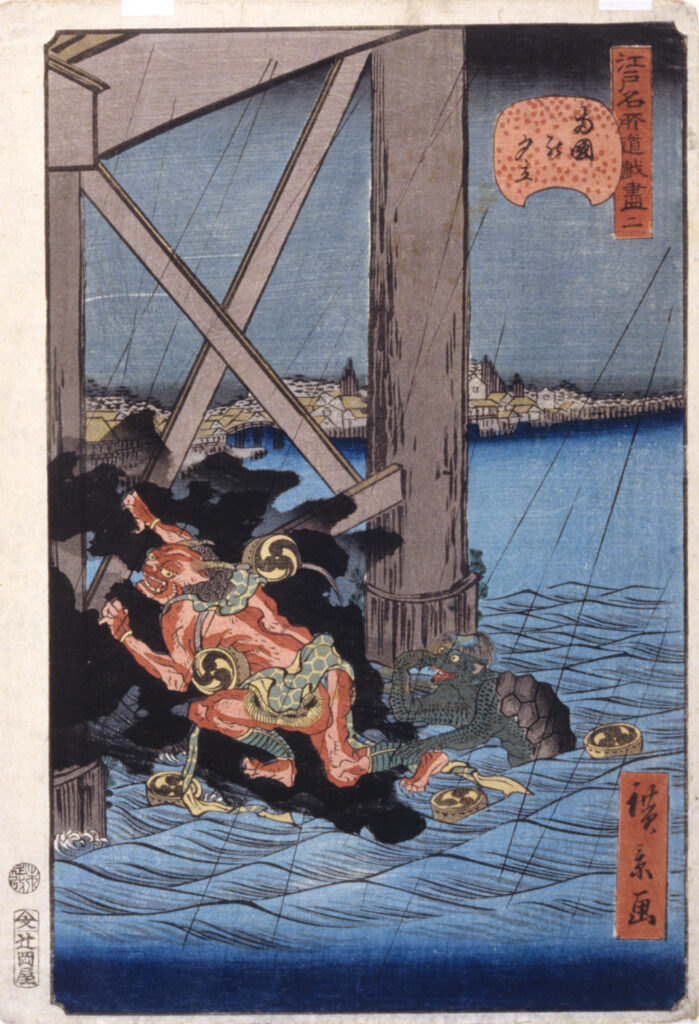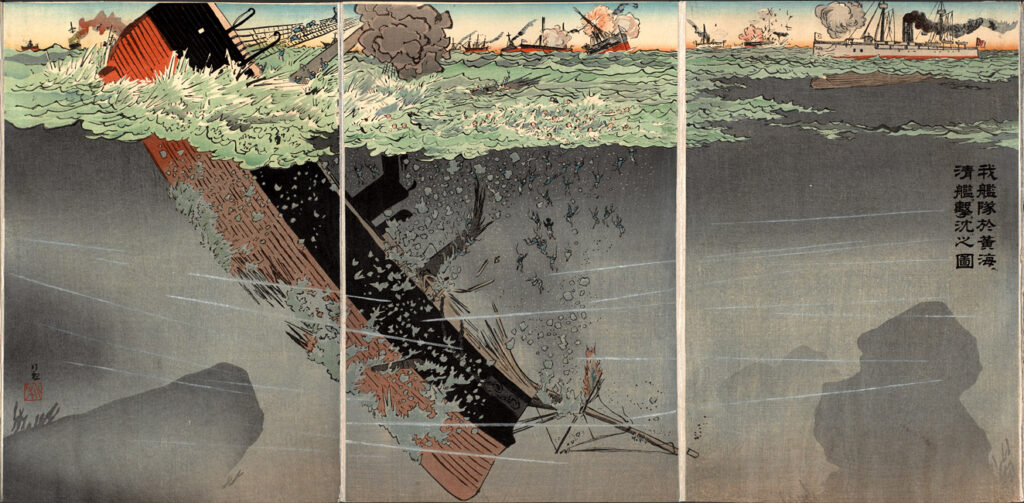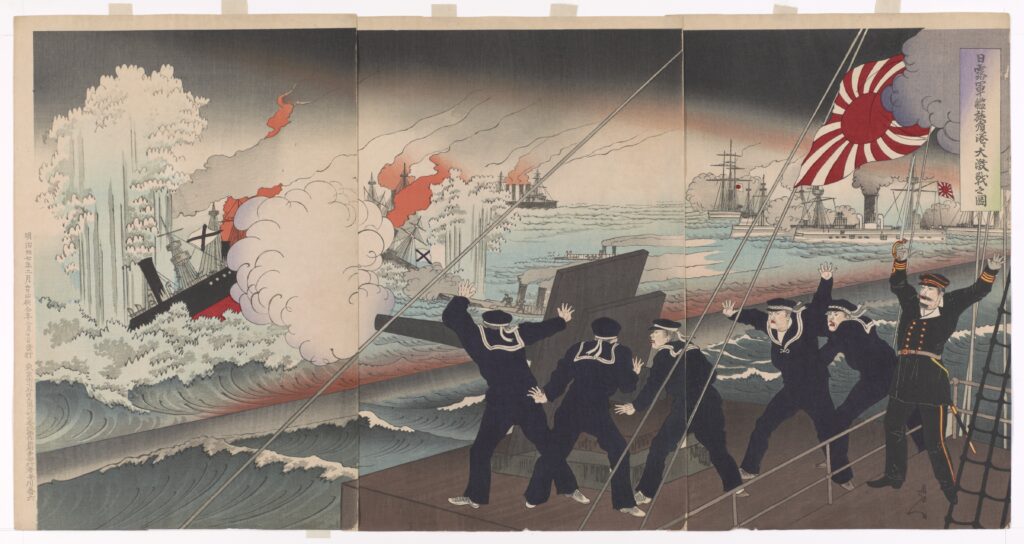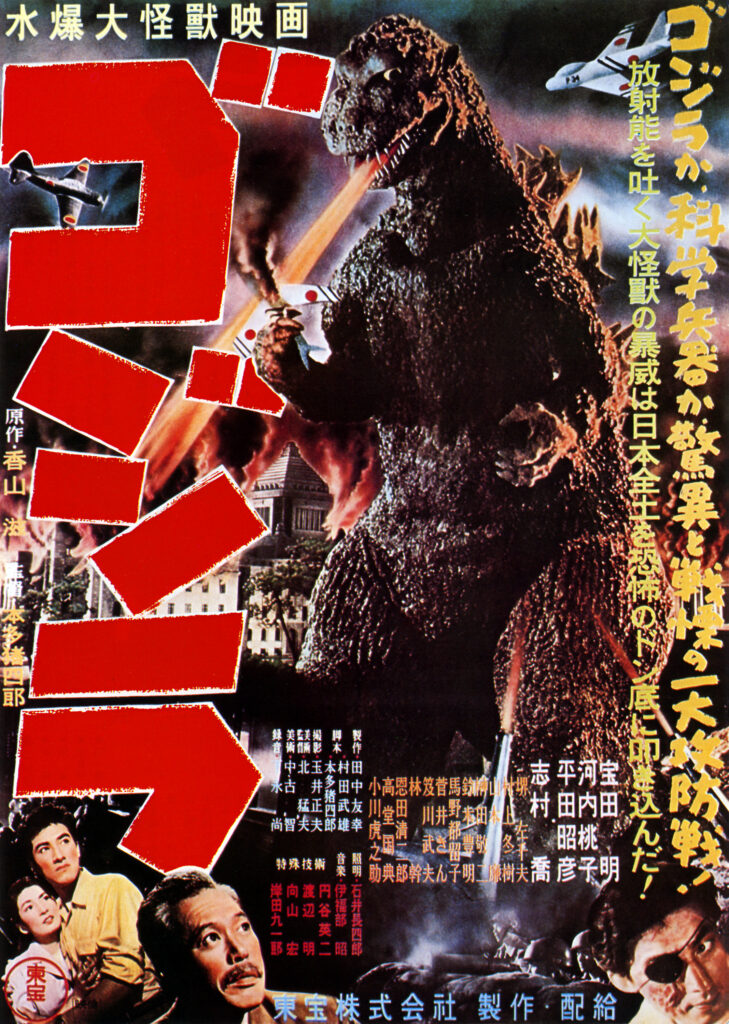The exhibition Monsters, Water, and War examines the influence of folk tales and military history on the art and culture of Japan through five images which cover multiple styles and historical periods. With these five images, the deep rooted connection between Japan’s pop culture today the folklore of the past, and the imperialist history of the island nation becomes apparent. Beginning with two woodblock prints from the very end of the Edo period, the exhibition continues through the Meiji era and finally into the post war period with an iconic movie poster that is recognizable across the globe. Arranged in chronological order, the first image of the exhibition is a woodblock print entitled Evening Shower at Ryogoku, and was created in 1859 by artist Utagawa Hirokage. The print features two monsters crawling out of a river by the city of Ryogoku, one of which appears similar to a turtle. This turtle-esque monster is an early example of a reptilian beast crawling out of the water in Japanese art, a theme that will continue throughout the exhibition. The next image is another Edo period woodblock print from 1865, entitled Kiyohime, Emerging from the Hidaka River, Turning into a Serpent. The image is a scene from a Japanese folk tale over 1,000 years old that tells the story of Kiyohime, the woman featured in the print, and Anchin, a buddhist monk with whom she has fallen in love. After Anchin rejects Kiyohime in the story, she chases him across the Hidaka river and emerges on the other side as an enraged serpent. After crawling out of the water in her new reptilian form, Kiyohime kills the monk by breathing fire onto a large bell in which he was hiding. The exhibition continues into the Meiji era, when the Emperor of Japan regained control over the entire island, ending the rule of the shogunate which had been in place for centuries. It was during this time that Japan embarked on a series of imperialist conquests to expand their influence in East Asia. Two woodblock prints from the Meiji era are featured in the exhibition, the first of which is a scene from the First Sino-Japanese War. This conflict saw the Empire of Japan and the Qing Dynasty of China battle for control over the Korean peninsula, as well as for dominance of East Asia entirely. The war was disastrous for the Qing, who had recently attempted to quickly modernize their military to compete with an increasingly powerful Japan, and marked a shift of power in East Asia from China to Japan. The image Scene From Naval Battles in the Sino Japanese War shows a naval battle between the two nations, with ships set ablaze at the surface and sinking into the depths. The other battlefield featured in the exhibition is Scene from Russo Japanese War, which shows Japanese sailors celebrating their victory over the Russian Navy. The Russo Japanese War saw Japan unexpectedly defeat the Russian Empire, destroying the Tsar’s entire Pacific fleet. In the span of just a decade, the Empire of Japan had eclipsed two of the world’s former great powers. It was from the fire of war and battle on the sea that the larger than life monster featured in the last image was born. Godzilla, a creature known worldwide as a pop culture icon, came about during the postwar period in Japan. Japan’s imperial expansion rapidly came to an end with World War II, when the nation was utterly defeated by the Allies in one of the most brutal theatres of war in all of history. The war culminated in the bombings of Hiroshima and Nagasaki, when the United States used atomic weapons for the first and only time in the history of war. The utter destruction and suffering brought on by the bombs would serve as the basis of the inspiration for the Godzilla films. In the original movie, Godzilla emerges from the sea empowered by radiation, and proceeds to wreak havoc on the people of Japan. He breathes radioactive fire all over the city, a metaphor for when Hiroshima and Nagasaki were destroyed in a radioactive fireball. The theme of a reptilian beast emerging from the water which was examined earlier in Monsters, Water, and War culminates here, with a superstar monster influenced by centuries of Japanese art and history.
Works Cited
Images:
- Evening Shower at Ryogoku
http://collection.imamuseum.org/artwork/70991/
- Kiyohime Emerging from the Hadika River Turning Into a Serpent
- Scene From Naval Battles in the Sino Japanese War
- Russo-Japanese War
- Godzilla Theatrical Release Poster
Texts:
Deborah Shamoon. “The Yōkai in the Database: Supernatural Creatures and Folklore in Manga and Anime.” Marvels & Tales 27, no. 2 (2013): 276-89. Accessed March 18, 2021. doi:10.13110/marvelstales.27.2.0276.
Pflugfelder, Gregory M. “Godzilla: A Monster in Midtown.” Impressions, no. 36 (2015): 114-21. Accessed March 18, 2021. http://www.jstor.org/stable/24869056.




